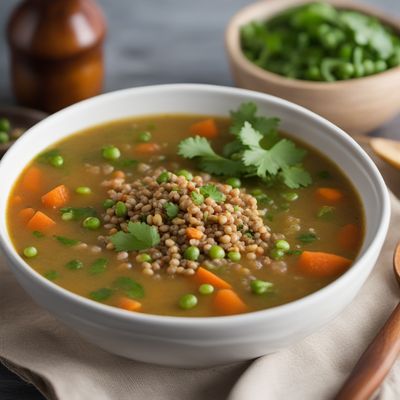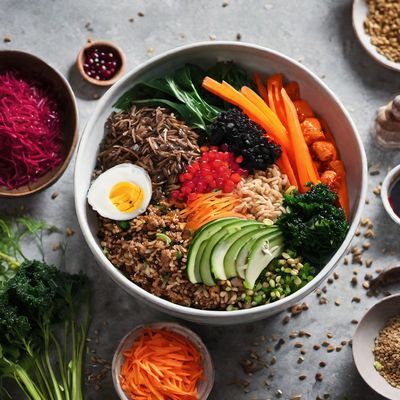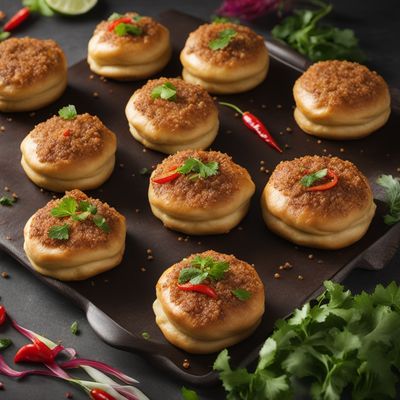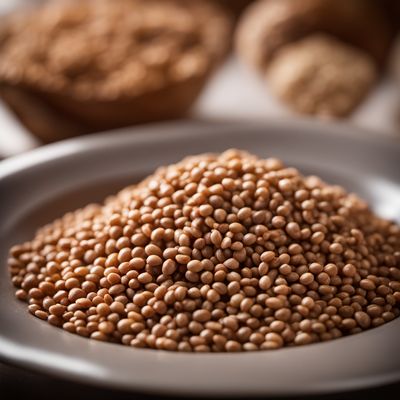
Ingredient
Quinoa grain
The Ancient Superfood: Quinoa Grain
Quinoa grain, scientifically known as Chenopodium quinoa, is a small, gluten-free seed that is often mistaken for a grain due to its similar culinary uses. It has a delicate texture and a mild, nutty flavor that adds depth to a variety of dishes. The seeds are small and round, with colors ranging from white to red to black. Quinoa is known for its unique composition of essential amino acids, making it a complete protein source. It is also rich in fiber, vitamins, and minerals, making it a nutritious addition to any diet.
Origins and history
Quinoa has been cultivated in the Andean region of South America for over 5,000 years. It was a staple food for the Incas and played a significant role in their culture and religious ceremonies. Quinoa was considered a sacred crop and was even referred to as the "mother grain." Despite its long history, quinoa gained global recognition only in the past few decades, as its exceptional nutritional value and versatility became more widely known.
Nutritional information
Quinoa grain is a nutritional powerhouse, packed with protein, fiber, and essential vitamins and minerals. It is particularly rich in iron, magnesium, phosphorus, and manganese. Additionally, it is a complete protein source, containing all nine essential amino acids.
Allergens
Quinoa grain is generally considered safe for individuals with gluten allergies or sensitivities, as it is naturally gluten-free. However, some individuals may experience an allergic reaction to quinoa, particularly if they have a sensitivity to other grains in the same botanical family, such as amaranth or buckwheat.
How to select
When selecting quinoa grain, look for packages that are tightly sealed and free from moisture or signs of insect infestation. Opt for organic varieties whenever possible to ensure the absence of pesticides. Additionally, check the expiration date to ensure freshness.
Storage recommendations
To maintain the freshness and quality of quinoa grain, store it in an airtight container in a cool, dry place, away from direct sunlight. Properly stored, quinoa can last for up to two years.
How to produce
Quinoa can be grown by amateur gardeners in regions with cool climates and well-drained soil. It requires full sun exposure and can be sown directly in the ground or in containers. The plants are hardy and can tolerate drought conditions, making them suitable for home cultivation.
Preparation tips
Before cooking quinoa, it is essential to rinse it thoroughly under cold water to remove the bitter coating called saponin. Use a fine-mesh sieve and rub the grains gently to ensure thorough rinsing. To cook quinoa, combine one part quinoa with two parts water or broth in a saucepan. Bring to a boil, then reduce the heat and simmer for about 15 minutes or until the liquid is absorbed. Fluff the cooked quinoa with a fork before serving. Quinoa can be used as a base for salads, added to soups and stews, or enjoyed as a side dish.
Culinary uses
Quinoa grain is incredibly versatile and can be used in a variety of culinary applications. It can be cooked and used as a nutritious substitute for rice or pasta, added to salads for extra texture and protein, or used as a stuffing for vegetables. Quinoa flour can also be used in baking to add a nutty flavor and enhance the nutritional value of baked goods.
Availability
Quinoa is commonly available in most grocery stores and supermarkets worldwide. It is also cultivated in countries such as Peru, Bolivia, Ecuador, and the United States.
More ingredients from this category
Recipes using Quinoa grain » Browse all

Yin Yang Fried Rice with a Twist
Harmony on a Plate: Yin Yang Fusion Fried Rice

Peruvian-Inspired Gumbo
Andean Gumbo: A Fusion of Flavors

Peruvian Quinoa Salad with Creamy Avocado Dressing
Andean Delight: Quinoa Salad with Creamy Avocado Dressing

Lebanese-Inspired Quinoa Tabbouleh
Quinoa Tabbouleh: A Refreshing Twist on a Lebanese Classic

Bolivian-style Bazun Hin
Andean Delight: Bolivian-inspired Bazun Hin

Peruvian-Inspired Breakfast
Machu Picchu Morning Delight

Peruvian Quinoa Soup
Andean Delight: Peruvian Quinoa Soup

Peruvian-style Nasibal
Quinoa-Stuffed Plantain Delight

New Nordic Bibimbap
Nordic Fusion Bowl: A Twist on Traditional Bibimbap

Bolivian-Style Stuffed Buns
Andean Delights: Bolivian Stuffed Buns with a Twist

Krpice sa zeljem (Peruvian Style)
Andean-Inspired Krpice sa zeljem

Stuffed Bell Peppers with Quinoa and Black Beans
Quinoa Fiesta Stuffed Peppers


